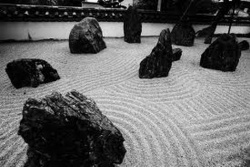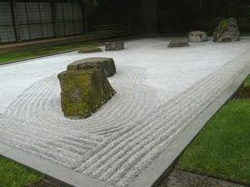The Surangama Sutra Warning to Practitioners Section Summary
The Falseness of the Five Skandhas
Having heard the Buddha's instruction, Ananda rose from his seat and prostrated himself at the master's feet. Then without forgetting a single word, he recited the Buddha's message to the assembled. Now addressing the Buddha he said: "The five kinds of falsehoods arising from the five skandhas are rooted in the thinking mind, but we have not yet received your detailed explanation. Moreover, should the five skandhas be wiped out simultaneously or one at a time, and what are the boundaries between them? We only hope that in your compassion you will purify our vision so that we may serve as guiding lights for all living things in the dharma-ending age ahead."
The Buddha said to Ananda: "In the enlightened state there is no trace of birth and death, defilements, or even voidness, for these all arise from false thinking. It is from this primal enlightened mind that arises the illusion of the material world, just like Yajnadatta, who convinced himself that his real head was a mere shadow. Falsehood fundamentally is without cause, but its causality is produced by false thinking. Those
who are confused by this causality consider it perfectly natural. Even voidness is in truth an illusion, how much more so causality and nature. All of these are examples of the skandha of volition functioning in the false minds of living things.
"Ananda, if you know the source of false thinking, then you can speak of its cause. However, if there is no source of false thinking, then the source of the cause of false thinking does not exist. How must less when you do not know its source and regard it as spontaneous? For this reason the Tathagata must enlighten you that the root cause of the five skandhas is in all cases false thinking.
"The original cause of your body is your parent's thought to give birth, but without a thought in your mind to be born there would have been no way for the thought of your incarnation to enter their minds. As I have said before, if you think of the taste of vinegar in your mind, your mouth will begin to water; if you think of scaling great heights, the soles of your feet will begin to feel sore. However, neither the mountain cliff nor the vinegar actually exist. If your body were not subject to the same falsehood, how could saliva appear at the mention of vinegar? Therefore, you should know that your physical form is called 'substantiality,' or the first kind of false thinking.
"As I have mentioned, the mere thought of scaling great heights was sufficient to produce the sensation of soreness, and this sensation was able to affect your body. These positive or negative feelings run about wildly together. This is called 'empty reflection,' or the second kind of false thinking.
"Your thoughts are able to direct your body; if your body was not the same as your thoughts, how could your body follow the orders of your body? From all our impressions of the external world, the mind generates thoughts and the body reacts. In the waking state the thinking mind is active, and in sleep these thoughts manifest as dreams. Thus it is thoughts that stir up false feelings. This is called 'pervasiveness,' or the third kind of false thinking.
"The process of transformation never ceases, and everything is in constant motion.Nails grow and hair sprouts, energy declines, and wrinkles appear. This goes on day and night without our noticing. Ananda, if this is not you, how can your body undergo these changes; if it really is you, how is it that you are unaware of them? Therefore,there is continuity in the functioning of discrimination that goes on unceasingly. This
is called 'concealment,' or the fourth kind of false thinking.
"Furthermore, if you say that your perfect, clear, still, and unshakable consciousness is permanent, why does it not go beyond what you see, hear, feel, and know? If it is the real, it should not be influenced by false habits. How is it that you have experienced viewing a strange object in the past, and after many years completely forgotten about it, but suddenly when you see the same unusual object again, you seem to remember it as if it were never lost. This shows the continual contamination of your perfect, profound, and unshakable consciousness. How can this be determined? Ananda, you must know that this mental stillness is not genuine. It is like flowing water that looks still at first glance, but is simply flowing too fast for us to perceive it. It is not that there is no flow. If consciousness is not the source of false thinking, how can one be influenced by wrong habits. If you are not able to harmonize the functioning of the six senses, you will never be able to wipe out false thinking. Thus what you experience as seeing, hearing, feeling, and knowing is a subtle sequence of old habits, and your inner stillness and apparent absence of impressions is not genuine. The fifth kind of confusion is 'subtle thinking.'
"Ananda, these five skandhas all arise from the five kinds of false thinking. If you wish to know the shallowness or depth of the causes and boundaries of the skandhas, they are as follows: form and voidness are the boundaries of the skandha of form; contact and separation are the boundary of the skandha of sensation; memory and forgetfulness are the boundaries of the skandha of conception; destruction and creation are the boundaries of the skandha of volition; entering in stillness and uniting with stillness are the boundaries of the skandha of consciousness.
"These five skandhas build one upon the other. They originate with the skandha of consciousness, but their elimination must begin with the skandha of form. In theory they all disappear with sudden enlightenment, but in reality it is not the work of an instant. Rather, they are overcome gradually one by one in order. I have already shown you how to unite the six knots in a cloth. What is still unclear that prompts you to inquire further? You should grasp the root cause of false thinking and issue a warning to practitioners in the dharma-ending age ahead, that they may come to understand its falsehood and learn to detest its arising, and so that they learn of nirvana and not become enamored of the three worlds of desire, form, and formlessness.
"Ananda, if there is a man whose being expands to fill the ten directions of space with all its seven treasures and who then offers these to the Buddhas as numberless as particles of dust and serves them devotedly with a faultless mind, what would you say of him? What are the rewards of serving the Buddha in this way?
Ananda replied: "Space is infinite and the treasures within are boundless. Once a man offered only seven coins to seven Buddhas, and for this he was rewarded with rebirth as a heavenly king; how much more so the illimitable rewards of serving the Buddhas with unimaginable treasures that fill space and the Buddha-lands."
The Buddha answered Ananda saying: "The words of the Buddhas and Tathagatas are without falseness. If there was another man, who though guilty of committing the four sins and ten sins, and after experiencing all manner of eternal hells, in one instant had a desire to open this dharma-door in the dharma-ending age for the benefit of the uninitiated, this man's sins would be wiped out and his suffering in hell would become joy in heaven. His reward would exceed that of the other man who faithfully served the Buddhas by a hundredfold, thousandfold, ten thousandfold, and incalculable times.
"Ananda, those who read this sutra, uphold these vows, and practice my teachings will gain merit that transcends this kalpa. If you are able to rely on my teachings and practice accordingly, you will achieve bodhi and not be disturbed by the maras."
After the Buddha had expounded this sutra, all the monks, nuns, male and female devotees, together with all the devas, men, bodhisattvas, sravakas, pratyeka-buddhas, rsis, and newly initiated ghosts and spirits were all filled with great joy, bowed to the Buddha, and departed.


